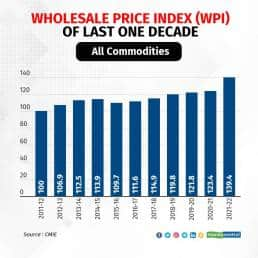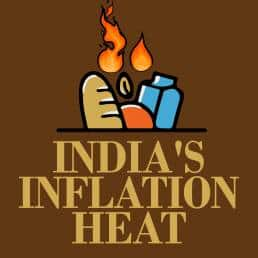



Wholesale prices in India rose 15.1 percent in April from a year earlier, the most in three decades, increasing cost pressures on producers and likely affecting growth, economists said.
Inflation as measured by the Wholesale Price Index was at the highest level on record in the current 2011-12 series. Prices of food, fuel and manufacturing registered an exponential spike in April, with the sharpest increases in fuel and power prices.
While WPI has risen considerably since 2015, the 13 percent jump between FY21 and FY22 was the highest.

Global factors
The index is dominated by manufactured products, which have a weight of 64 percent and are influenced significantly by global factors such as the pandemic and geopolitical tensions. Consequently, an increase in global prices gets reflected more in the WPI, according to economists.
“The key factors behind the increase in the WPI are elevated global commodity prices and the depreciating rupee (which makes India’s imports more expensive),” said Sonal Badhan, an economist with Bank of Baroda. “Global commodity prices, in turn, have come under pressure due to supply-chain bottlenecks due to rising Covid-19 cases in China and due to the Russia-Ukraine war.”

The warring countries produce a range of commodities. Russia and Ukraine together contribute 6.9 percent of the global production of iron ore. Russia produces 5.4 percent of the world’s aluminium and 3.8 percent of its copper and steel.
In terms of agricultural produce, Russia and Ukraine together supply 14.1 percent of the world’s wheat, 6.1 percent of coarse grain and 7.7 percent of oilseeds.
With the outbreak of the war, the supply of all these items has been disrupted, leading to higher prices, economists said.
“Apart from the war impairing supply in key commodities, if we look at the past 12 months, prices of food, fuel and metals have also been driven up by excess policy stimulus in advanced countries (particularly the US), zero-Covid policy in China preventing normalisation in the supply chain, OPEC curtailing crude oil supply, and inclement weather,” said Prithviraj Srinivas, chief economist at Axis Capital.
Consumers to suffer
With WPI on the rise, it is likely that consumers won’t be spared the heat.
“Producers are expected to pass on rising input costs to end-users. This could further weigh on retail inflation,” said Swati Arora, an economist at HDFC Bank.
With the overall recovery in demand, the transmission of increased prices to the retail basket (Consumer Price Index) from WPI has been higher, according to several economists.
“In the early periods of the pandemic, the demand situation was weak, which resulted in minimal transmission of input costs to CPI as firms wanted to maintain their market share in an uncertain environment,” said Sarbartho Mukherjee, an economist with the Mahindra Group.
He said consumer goods and auto companies are gradually increasing their retail prices and passing on higher input costs to consumers to protect their bottom line. There will also be no respite for small business owners and local shopkeepers and they will continue to remain vulnerable to wholesale inflation.
“This will force the businesses to raise prices and absorb higher costs within their thin margins. The attendant decline in household purchasing power will reduce demand for the products and negatively impact sales,” said Shashank Mendiratta, an economist from New Delhi.
At the macro level, higher prices are a market mechanism to ration commodities that are now in short supply. This means the burden will fall on households, especially from the lower-income strata, to rationalise consumption or look for less expensive substitutes.
In the case of petrol and diesel, higher prices will likely drive a shift towards electric vehicles, CNG vehicles and public transport.
“Some households will return to dirtier fuels like firewood and dung cake for cooking. For example, the CPI basket is already showing higher prices for these inferior substitutes. In sum, higher inflation is likely to impinge on the quantity as well as quality of the Indian consumption basket in FY23,” added Srinivas of Axis Capital.
Overall growth at stake
The pass-through of higher costs can dent consumption demand and even if such price increases are not fully passed on, companies that absorb higher input costs will be hurt by lower profitability and reduced growth. That may hinder investments and raise other concerns.
Also read: Consumer price inflation surges to near-8-year high at 7.79% in April
“Concerns for the government will be through lower tax collections if income/profit/demand wanes in the wake of higher prices,” added Badhan.
Growth will be impacted as households and businesses rationalise consumption. A sharp rise in inflation imparts uncertainty to demand outlook, which then becomes a headwind for business sentiment due to prospects of weaker revenue or profit margins.
“Higher input costs are likely to put stress on profit margins and could slow down the recovery in the private capex cycle,” said Arora.
Discover the latest Business News, Sensex, and Nifty updates. Obtain Personal Finance insights, tax queries, and expert opinions on Moneycontrol or download the Moneycontrol App to stay updated!
Find the best of Al News in one place, specially curated for you every weekend.
Stay on top of the latest tech trends and biggest startup news.